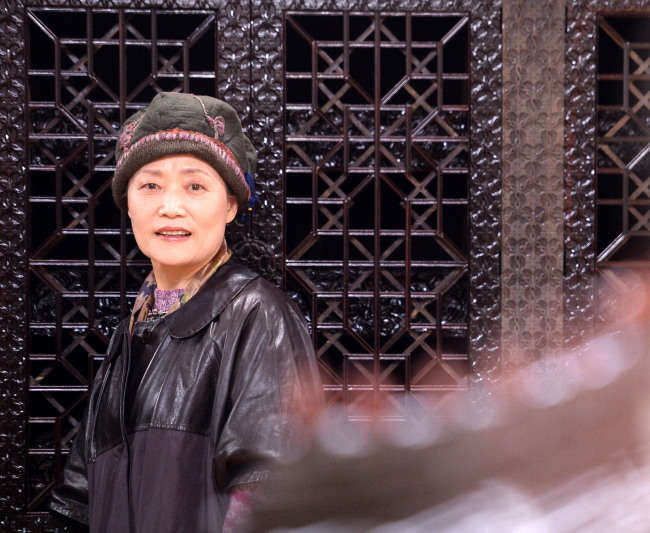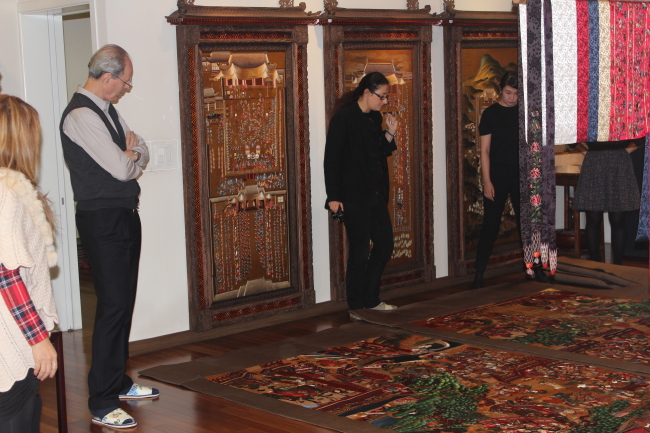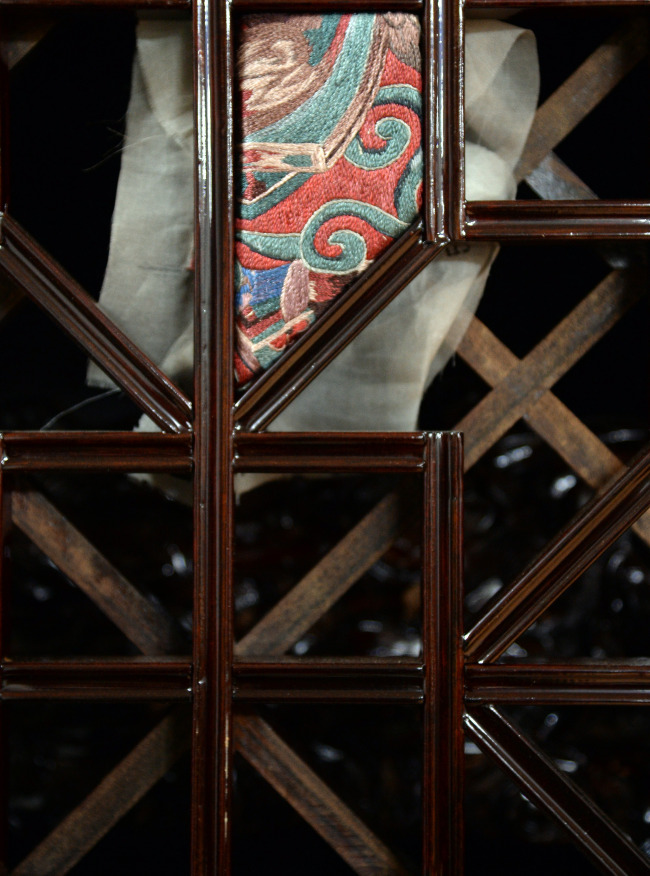Embroidery elevated to an art form
With thread and needle, ‘silgeurim’ artist Son In-sook ‘paints’ her inner world
By Korea HeraldPublished : Dec. 19, 2014 - 21:27
From the outside, the private museum looks like any other apartment unit in Seoul. Open the metal door, however, and your eyes are dazzled by what unfolds before you: an entire apartment filled with embroideries on the wall, embroidered folding screens, and cabinets and tables decorated with intricate embroideries. In fact, every surface seems to be covered with needlework.
Some of them are so fine and intricate that from a distance they appear to be paintings. Some are so hyperrealistic that they are easily mistaken for photographs. The silver and gold embroidery decorating a chest of drawers shimmers in the light, and you won’t be faulted for thinking that it was a piece of furniture with mother-of-pearl inlay.
be paintings. Some are so hyperrealistic that they are easily mistaken for photographs. The silver and gold embroidery decorating a chest of drawers shimmers in the light, and you won’t be faulted for thinking that it was a piece of furniture with mother-of-pearl inlay.
The works are the labor of love of Son In-sook, an embroidery artist who prefers to be called a “silgeurim artist” in reference to the art she practices ― painting with thread.
“I work without outlines, letting the thread and the needle roam on the canvas as I paint freely,” Son told a group of foreign and Korean visitors on an autumn evening. Unlike traditional Korean embroidery done in women’s quarters, her works express an artist’s philosophy and view of art, she elaborated.
Some of them are so fine and intricate that from a distance they appear to
 be paintings. Some are so hyperrealistic that they are easily mistaken for photographs. The silver and gold embroidery decorating a chest of drawers shimmers in the light, and you won’t be faulted for thinking that it was a piece of furniture with mother-of-pearl inlay.
be paintings. Some are so hyperrealistic that they are easily mistaken for photographs. The silver and gold embroidery decorating a chest of drawers shimmers in the light, and you won’t be faulted for thinking that it was a piece of furniture with mother-of-pearl inlay. The works are the labor of love of Son In-sook, an embroidery artist who prefers to be called a “silgeurim artist” in reference to the art she practices ― painting with thread.
“I work without outlines, letting the thread and the needle roam on the canvas as I paint freely,” Son told a group of foreign and Korean visitors on an autumn evening. Unlike traditional Korean embroidery done in women’s quarters, her works express an artist’s philosophy and view of art, she elaborated.

Her works range from renditions of Buddhist paintings and famous Korean paintings to her original realistic and abstract works. Many of the works, such as an embroidery rendition of Joseon-era painter Shin Yun-bok’s iconic painting, “Portrait of a Beauty,” use strands of real human hair in lieu of thread to depict the hair.
Son, 65, began doing embroidery at age 10 under the guidance of her mother. In fact, her 90-year-old mother, who lives in Busan, continues to be her mentor and the two regularly correspond by letters. “My mother said, ‘If you create forests, tigers will come to live and birds will fly in. Communicate with the outside when your works are nearly complete and organized,’” Son recalled.
And the time to step out into the world seems to have arrived. Her works are to be exhibited at the Guimet Museum of Asian Art in Paris next year as part of the events celebrating the 130th anniversary of diplomatic relations between Korea and France. “The museum said my works will be the only works by a living artist ever to be shown at the museum,” said Son.

This is a monumental step for Son, who began showing her works privately five years ago. Her plan for a museum in Suseo, Gyeonggi Province, just outside Seoul, has been stalled since 2009, when it hit opposition from area residents.
Son’s apartment museum is literally filled from ceiling to floor with a prodigious body of work, many of the larger works stored on the floor, rolled away for lack of exhibition space. However, Son said she never considered selling. “I wanted to create a cultural heritage for the future generations so that when people from around the world come to Korea, we have our cultural dignity to show them,” she said. “If I had sold them, this sort of dream could not have been realized.”
To complete her work, Son collaborates with seven master artisans, including a woodworking artisan based near Gonjiam, Gyeonggi Province, about an hour from Seoul. The studio here is filled with the distinctive smell of lacquer.
This studio is also where a monumental work that is now 20 years in the making is being created.

The set of four large chests of drawers with intricate lattices on 96 doors and tops in the form of “hanok” roofs are carved from ebony, coated with eight layers of varnish and dried in an environment that is carefully monitored for humidity.
When completed in a few years, each small section of the lattice will be filled with a patch of embroidery. Son has already finished embroidering the several thousand pieces that will be used. “The embroidery motif is the traditional ‘dancheong.’ However, the colors are my own colors, somewhat muted and noble in character,” Son explained. “Dancheong” refers to traditional paintings used on hanok, traditional Korean houses, that typically feature bright colors.
“It started out as a ‘house’ to store clothes in. Then my vision got bigger and now this is a combination of embroidery and architecture,” Son said, standing in front of the shorter and wider yin component of the yin and yang pair of chests of drawers.
Son said she had poured all her talent and money into creating her collection. “I am very grateful to my family, who have supported me financially and emotionally in my efforts,” she said.
From the time she gets up in the morning to the time she goes to bed, her whole day is devoted to her work. “I have been taking walks every morning for the last 20 years without fail. I often find inspiration during these walks,” she said. Then she devotes several hours to embroidery.
Don’t her shoulders ache and her eyes get tired?
“But that is just part of the work. It doesn’t bother me at all,” she said.
(khooran@hedraldcorp.com)
-
Articles by Korea Herald







![[Graphic News] More Koreans say they plan long-distance trips this year](http://res.heraldm.com/phpwas/restmb_idxmake.php?idx=644&simg=/content/image/2024/04/17/20240417050828_0.gif&u=)
![[KH Explains] Hyundai's full hybrid edge to pay off amid slow transition to pure EVs](http://res.heraldm.com/phpwas/restmb_idxmake.php?idx=644&simg=/content/image/2024/04/18/20240418050645_0.jpg&u=20240419100350)








![[KH Explains] Hyundai's full hybrid edge to pay off amid slow transition to pure EVs](http://res.heraldm.com/phpwas/restmb_idxmake.php?idx=652&simg=/content/image/2024/04/18/20240418050645_0.jpg&u=20240419100350)

![[Today’s K-pop] Illit drops debut single remix](http://res.heraldm.com/phpwas/restmb_idxmake.php?idx=642&simg=/content/image/2024/04/19/20240419050612_0.jpg&u=)